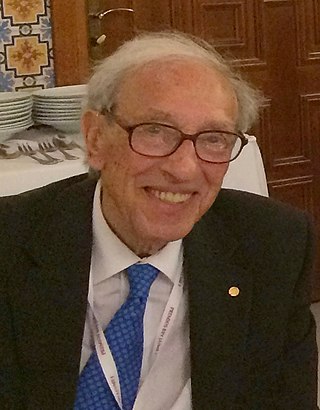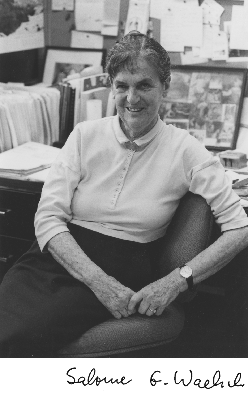
Glendale is a city in St. Louis County, Missouri, United States. The population was 5,925 at the 2010 census.

Carl Ferdinand Cori, ForMemRS was a Czech-American biochemist and pharmacologist. He, together with his wife Gerty Cori and Argentine physiologist Bernardo Houssay, received a Nobel Prize in 1947 for their discovery of how the glucose derivative glycogen is broken down and resynthesized in the body for use as a store and source of energy. In 2004, both Coris were designated a National Historic Chemical Landmark in recognition of their work that elucidated carbohydrate metabolism.

Gerty Theresa Cori was an Austrian-American biochemist who in 1947 was the third woman to win a Nobel Prize in science, and the first woman to be awarded the Nobel Prize in Physiology or Medicine, for her role in the "discovery of the course of the catalytic conversion of glycogen".

Bernardo Alberto Houssay was an Argentine physiologist. Houssay was a co-recipient of the 1947 Nobel Prize for Physiology or Medicine for discovering the role played by pituitary hormones in regulating the amount of glucose in animals, sharing the prize with Carl Ferdinand Cori and Gerty Cori. He is the first Latin American Nobel laureate in the sciences.

Christian René Marie Joseph, Viscount de Duve was a Nobel Prize-winning Belgian cytologist and biochemist. He made serendipitous discoveries of two cell organelles, peroxisome and lysosome, for which he shared the Nobel Prize in Physiology or Medicine in 1974 with Albert Claude and George E. Palade. In addition to peroxisome and lysosome, he invented scientific names such as autophagy, endocytosis, and exocytosis in a single occasion.

Earl Wilbur Sutherland Jr. was an American pharmacologist and biochemist born in Burlingame, Kansas. Sutherland won a Nobel Prize in Physiology or Medicine in 1971 "for his discoveries concerning the mechanisms of the action of hormones", especially epinephrine, via second messengers, namely cyclic adenosine monophosphate, or cyclic AMP.

Arthur Kornberg was an American biochemist who won the Nobel Prize in Physiology or Medicine 1959 for the discovery of "the mechanisms in the biological synthesis of ribonucleic acid and deoxyribonucleic acid" together with Spanish biochemist and physician Severo Ochoa of New York University. He was also awarded the Paul-Lewis Award in Enzyme Chemistry from the American Chemical Society in 1951, an L.H.D. degree from Yeshiva University in 1962, and the National Medal of Science in 1979. In 1991, Kornberg received the Golden Plate Award of the American Academy of Achievement and the Gairdner Foundation Award in 1995.

Edmond Henri Fischer was a Swiss-American biochemist. He and his collaborator Edwin G. Krebs were awarded the Nobel Prize in Physiology or Medicine in 1992 for describing how reversible phosphorylation works as a switch to activate proteins and regulate various cellular processes. From 2007 until 2014, he was the Honorary President of the World Cultural Council. At the time of his death at age 101 in 2021, he was the oldest living Nobel Prize laureate.

Eric Francis Wieschaus is an American evolutionary developmental biologist and 1995 Nobel Prize-winner.

Salome Gluecksohn-Waelsch was a German-born U.S. geneticist and co-founder of the field of developmental genetics, which investigates the genetic mechanisms of development.

Carl Rabl was an Austrian anatomist. His most notable achievement was on the structural consistency of chromosomes during the cell cycle. In 1885 he published that chromosomes do not lose their identity, even though they are no longer visible through the microscope.

Mildred Cohn was an American biochemist who furthered understanding of biochemical processes through her study of chemical reactions within animal cells. She was a pioneer in the use of nuclear magnetic resonance for studying enzyme reactions, particularly reactions of adenosine triphosphate (ATP).

Hans Horst Meyer was a German pharmacologist. He studied medicine and did research in pharmacology. The Meyer-Overton hypothesis on the mode of action on general anaesthetics is partially named after him. He also discovered the importance of glucuronic acid as a reaction partner for drugs, and the mode of action of tetanus toxin on the body.
Jane Anne Russell was an endocrinologist. She researched pituitary extract.

The First Faculty of Medicine of Charles University is one of five medical faculties of Charles University, Prague, Czech Republic. Founded in 1348 at the same time as the university itself, it is the oldest medical faculty in Central Europe and the 11th oldest medical institution in the world. Situated in the centre of Prague, the faculty provides education in all fields of general medicine. It is regularly ranked in the top 1% of medical faculties globally.
Ferdinand Albert Pax was a German zoologist who worked at the University of Wroclaw. He was the author of a monograph on the Hexacorallia in the series edited by Willy Kükenthal.
The Hodgkin family is a British Quaker family where several members have excelled in science, medicine, and arts.













